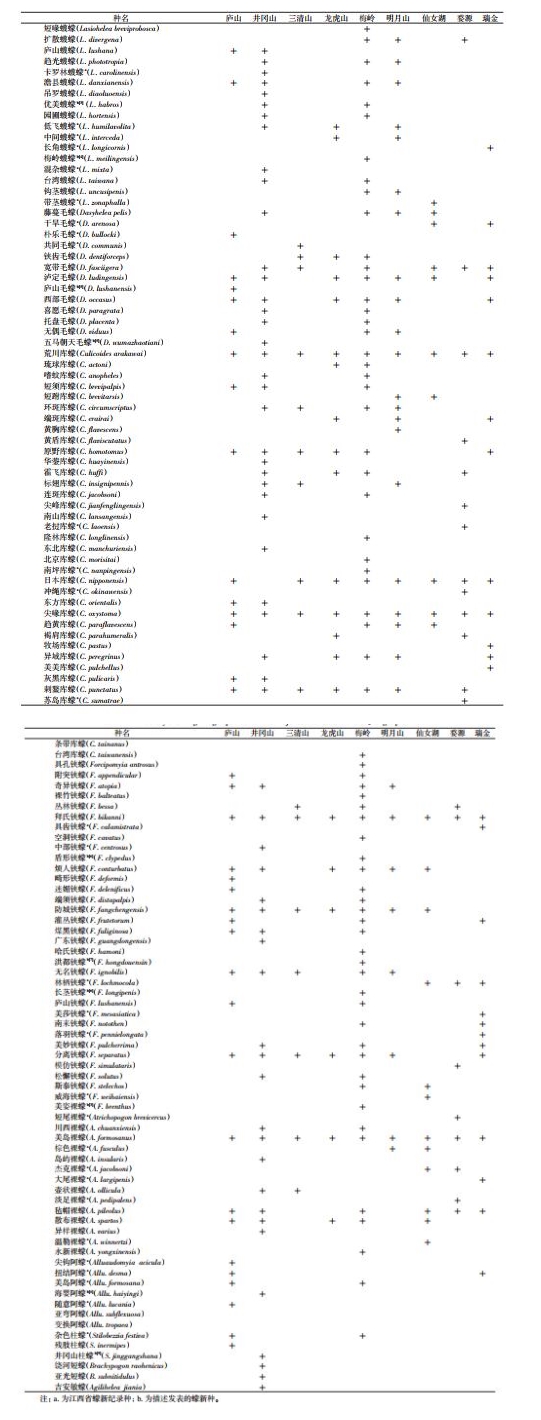An investigation and study of biting midges (Ceratopogonidae) in nine major tourist attractions in Jiangxi province, China
蠓是一类微小型昆虫.属双翅目(Diptera)蠓科(Ceratopogonidae), 体长多数为1~5 mm, 少数更微小者短约0.7 mm[1], 在世界范围内均有分布[2]。虞以新[1]于2006年首次对我国已知蠓科昆虫的区系特征进行了系统研究, 记载了我国已知的39属1015种蠓类, 主要包括细蠓亚科(Subfamily Leptoconopinae).铗蠓亚科(Subfamily Foreipomyinae)、毛蠓亚科(Subfamily Dasyheleinae)和蠓亚科(Subfamily Ceratopogoninae)4亚科共39属。其中库蠓属(Culicoides)、蠛蠓属(Lasiohelea)和细蠓属(Leptoconops)是我国重要的三大吸血蠓属。吸血蠓(bitingmidges)刺吸人、畜和禽类等动物血液, 传播人体奥柔普切热和牛羊蓝舌病等疾病.引起虫咬性皮炎等, 是重要的医学昆虫。
江西省位于长江以南,纬度较低.属亚热带季风湿润气候, 四季分明且天气复杂多变。境内丘陵起伏.溪流纵横、雨量充沛、植被葱郁, 适宜蠓科昆虫的孳生繁行。江西省旅游资源丰富, 目前尚未见对其境内主要旅游景区蠓科昆虫的系统调查研究报道,笔者于2011- 2017年每年的5-11月对江西省境内庐山等9个主要旅游景区蠓科昆虫进行了全面调查, 并首次对庐山、三清山、龙虎山梅岭、明月山、仙女湖、婺源县、瑞金市和井冈山共9个旅游景区蠓科昆虫的种群构成和名录进行了系统报道。
1 材料与方法
1.1 材料 诱虫灯(功夫小帅, 紫外灯24 W, 220 Ⅴ和蓄电池改装, 波长365nm); 捕虫网:60目纱制成的口径20cm, 深60cm, 末端钝圆的圆锥形捕虫网,网柄长70 cm; 莱卡(Leica)M205A和DFC550成像系统解剖镜。
1.2 调查生境和场所 分别选择江西省内九江市庐山、吉安市井冈山、上饶市三清山和婺源县、鹰潭市龙虎山、宜春市明月山、新余市仙女湖、南昌市梅岭国家风景区和赣州市瑞金共9个风景名胜或红色旅游景区做为蠓科昆虫调查点。
调查生境主要为旅游景区内、外及周边。具体为景区游客服务中心及周边居民区、酒店餐饮、农家乐或民宿; 景区内为各主要景点及其周边不同生境的阔叶林、针阔叶林等。
1.3 方法
13.1 调查方法 网捕法:主要用于白天不同生境蠓科昆虫的采集,每次3~5人同时挥网采集; 灯诱法:每生境每次布放3盏诱虫灯.每灯之间相距不少于50m, 晚放晨收; 人诱法:主要用于白天诱集吸血蠛蠓和细蠓。
1.3.2 蠓标本的保存制作和鉴定 将各类生境场所采获的蠓标本标记好浸泡于70%乙醇溶液内, 带回实验室解剖镜下进行属和常见种的鉴别和计数.制作标本玻片后显微镜下进行种的鉴定。蠓标本制作和蠓形态学属、种分类鉴定, 参照《中国蠓科昆虫》[1]。
1.4 数据统计 利用Excel 2007软件录人各类生境.场所捕获的蠓虫数, 汇总后计算蠓类的科、属和种构成。
2 结果
2.1 蠓科种类组成 在江西省9大旅游景区采获的标本经鉴定共有3亚科9属126种, 其中蠛蠓属(Lasiohelea)17种, 库蠓属(Culicoides)35种, 毛蠓属(Dasyhelea)13种,裸蠓属(Atrichopogon)15种,铗蠓属(Forcipomyia)33种, 阿蠑属Alluaudomyia)7种,柱蠓属(Silbezia)3种, 敏蠓属(Agilihelea)1种, 短蠓属(Brachypogon)2种。其中庐山7属37种, 井冈山9属57种, 三清山4属17种, 龙虎山5属21种, 梅岭7属66种, 明月山5属29种, 仙女湖5属22种, 婺源5属22种和瑞金6屆26种。首次记录了中间蠛蠓(L interceda)、带茎蠛蠓(L. zonaphalla)、低飞蠛蠓(L. humilavolia)、卡罗林蠛蠓(L carolinensis)、混杂蠛蠓(L. mixta)、长角蟣蠓(L longicornis)、共同毛蠓(D. communis)、干旱毛蠓(D. arenosa)、朴乐毛蠓(D. bullocki)等30个江西省蠓类新纪录种。共描述发表了梅岭蝮蠓(L.meilingensis)、五马朝天毛蠓(D. toumazhaotiani)、庐山毛蠓(D. lushanensis)、优美蠛蠓(L. habros)、美姿裸蠓(F. brenthus)、海婴阿蠓(Allu. haiyingi)、井冈山柱蠓(S. jinggangshana)、洪都铗蠓(F. hongdouensin)、盾形铗蠓(F. clypedus)和长茎铗蠓(F. longipenis)10个蠓新种。见表 1。
表 1 江西省9个主要旅游景区螺种名录
Table 1 Directory of biting midge species in nine major tourist attractions of Jiangxi province
2.2 蠓属的数量构成 2011- 2017年在江西省庐山等9个旅游景区共采集到蠓科昆虫30831只, 隶属3亚科9属,分别为毛蠓亚科(Subfamily Dasyheleinae Lenz)毛蠓属, 铗蠓亚科(Subfamily Foreipomyinae Lenz)铗蠓属、裸蠓属和蠛蠓属,蠓亚科(Subfamily Ceratopogoninae)库蠓属阿蠓属、敏蠓属、短蠓属和柱蠓属。库蠓属22678只, 占总采集蠓数的73.56%, 铗蠓属、毛蠓属、裸蠓属、蟣蠓属和其他蠓属分别占13.47%、9.40%. 2.13%、0.66%和0.78%。见表 2。
表 2 2011- 2017年江西省旅游景区蠓科昆虫属的数量构成
Table 2 Quantitative compositions of biting midge genera in tourist attractions of Jiangxi province, 2011- 2017
不同景区蠓属的数量构成比, 庐山、三清山、龙虎山、梅岭、明月山、婺源和井冈山主要以库蠓属为主, 所占比例分别为66.92%、73.84%、86.35%. 78.43%.72.68%.75.46%和66.78%;仙女湖和瑞金以铗蠓属为主, 分别占55.36%和44.53%, 其次为库蠓属, 分别占34.24%和37.88%。蠛蠓属除三清山未采集到标本外.在其他8个旅游景区均有采获.所占比例为0.11%~4.37%,其中以井冈山最高, 占4.37%,其次为梅岭, 占1.21%。见表 2。
2.3 主要吸血蠓种构成 由表 3可见.荒川库蠓为明月山、仙女湖.婺源.三清山和瑞金的优势蠓种, 分别占捕获总数的90.57%.65.93%.63.63%.51.06%和50.97%;尖喙库蠓为梅岭的优势种, 占65.42%;南山库蠓为井冈山的优势种, 占48.89%;荒川库蠓和尖喙库蠓为庐山的优势种, 分别占39.75%和39.57%;荒川库蠓、尖喙库蠓和日本库蠓为龙虎山的优势种,分别占39.35%.33.23%和25.24%。
表 3 2011- 2017年江西省旅游景区主要吸血蠓种构成比
Table 3 Composition ratios of main blood-sucking midge species in nine tourist attractions of Jiangxi province, 201 Ⅰ-2017
3 讨论 2011-2017年在江西省庐山、井冈山等9个旅游景区共采集到蠓科昆.虫30 831只, 隶属3亚科9属126种, 其中吸血蠓类主要为库蠓属和蝮蠓属的种类, 共计52种, 占所有蠓种的41.27%;非吸血蠓种74种, 占所有蠓种的58.73%。在多年的调查研究中新发现并描述了梅岭蠛蠓、优美蝮蠓、五马朝天毛蠓庐山毛蠓、洪都铗蠓.盾形铗蠓、长茎铗蠓、美姿裸蠓、海婴阿蠓和井冈山柱蠓共10个蠓新种[4-9],为国内外和江西省蠓种增添了新的内容.这一研究结果基本摸清了江西省9个主要旅游景区的蠓科昆虫特别是吸血蠓的本底情况, 为有效防制旅游景区吸血蠓提供了理论和生态依据。
本次调查结果显示, 荒川库蠓、尖喙库蠓和日本库蠓是江西省旅游景区分布广泛和种群丰富度较高的物种, 3种吸血库蠓在9个旅游景区均有分布(除井冈山未采集到日本库蠓外), 研究结果与笔者前期对江西省9个地市蠓科昆虫调查的种群构成及分布一致[10]。这3个吸血蠓种已经在欧洲和亚洲等国家被证实可传播禽畜类的禽类住白细胞原虫病(Leucoeytozoonsis)[11],鹿流行性出血热病毒(Epizootie hemorhagie disease virus, EHDV)[12]、非洲马瘟病毒(African horse sickness virus, AHSV)'; [13-14].施马伦贝格病毒(Schallenberg virus, SBV)和蓝舌病毒(Bluetongue virus, BTV)[15]。目前在江西省内未见有相关病例的报道,但仍需引起高度重视, 在传播媒介存在的情况下, --旦有病毒的输人, 在合适的环境气候作用下, 可能会导致病毒的迅速扩散, 造成严重的经济损失。
除此之外, 有一些吸血蠓种类吸血习性多样, 可兼吸人畜血液[16], 是一些人畜共患疾病的潜在传播媒介。库蠓属中的一些种类可通过刺叮吸血传播人体奥柔普切热(Oropouche fever), 该病主要分布在南美的特立尼达、巴西等国家,我国尚未发现。刺吸叮咬.骚扰并引起严重的结痂性皮炎是吸血蠓对人类的最直接影响,特别是在吸血蠓活动的高峰期夏秋季节, 在一些公园或是旅游景点休闲游玩时,会受到吸血蠓的骚扰, 给当地的旅游业带来一些负面影响, 如在加勒比海和苏格兰的部分地区.由于吸血蠓的危害使当地的旅游开发曾经一度的延缓搁置; 在美国田纳西州、佐治亚州和佛罗里达州吸血库蠓大量攻击人, 给当地人们的户外活动带来了严重影响[17]。在我国尚未见类似的报道, 可能源于蠓科昆虫体型微小, 不易识别和察觉, 居民被蠓叮咬后往往会误认为是蚊虫等其他吸血昆虫叮咬所致。旅游景区具有人流量大、人员来源和构成多样.因此及时开展江西省9大主要旅游景区及周边地区蠓科昆虫的种群构成和分布的调查研究, 可为旅游景区深人开展蠓科昆虫特别是吸血蠓及其传染病的防治提供种群生态等本底资料。
志谢
九江市疾病预防控制中心(CDC)、庐山区CDC、鹰潭市CDC、上饶市CDC、宜春市CDC新余市CDC婺源县CDC、赣州市CDC、瑞金市CDC、井冈山市CDC和南昌市湾里区CDC在现场调查采集给予帮助, 一并志谢
 2020, Vol. 31
2020, Vol. 31








